Vanilla is a beloved spice that comes from the pods of orchids in the genus Vanilla. Its amazing flavor and fragrance have made it a favorite in cooking and perfumery all over the world. Let’s dive into the fascinating history of vanilla and see how it went from being used in ancient civilizations to becoming a global favorite today.
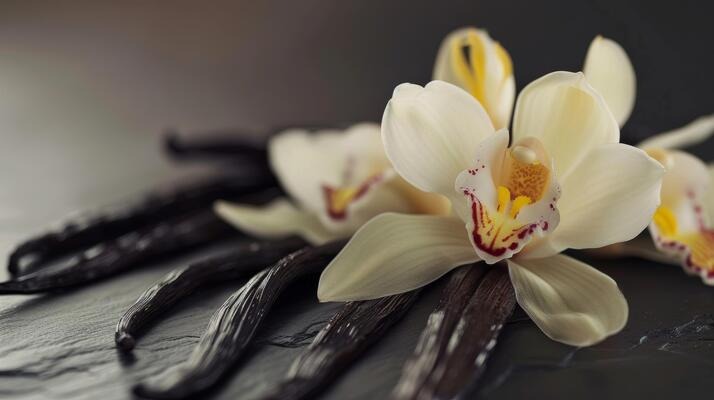
What is vanilla?
Vanilla is a flavoring derived from the pods of orchids of the genus Vanilla, primarily from the species Vanilla planifolia. The primary component of its distinctive flavor is the compound vanillin. It belongs to the vast orchid family, which encompasses approximately 25,000 species. It hails from South and Central America, as well as the Caribbean.
Early Origins
The oldest reports of vanilla use relate to the pre-Columbian Maya of southeastern Mexico/Central America, where vanilla was a cacao-beverage spice. However, most experts and historians agree that vanilla’s story begins in Mesoamerica, where the Totonac people of present-day Mexico are believed to be the first to cultivate vanilla orchids.
According to Totonac mythology, vanilla was a divine gift from the gods. The Aztecs later encountered vanilla through their conquests and began incorporating it into their culinary traditions, often combining it with cacao to create a luxurious beverage, chocolatl, consumed by the nobility and warriors .
European Introduction
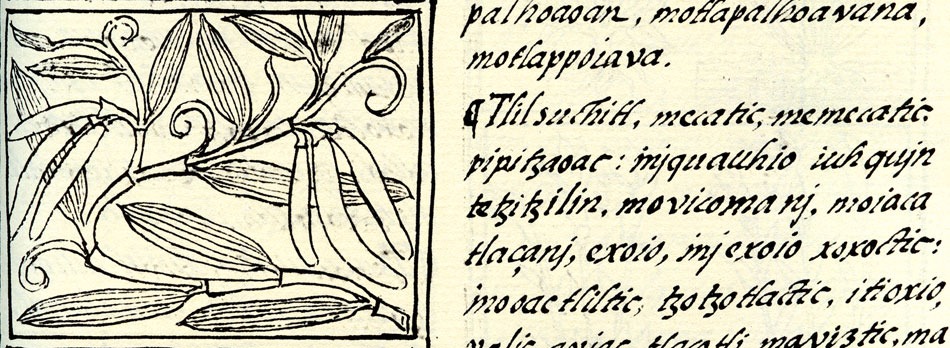
description of its use and properties written in the Nahuatl language/Wikipedia
Vanilla was introduced to Europe by Spanish conquistadors in the early 16th century. Hernán Cortés, who conquered the Aztecs, is credited with bringing vanilla, along with chocolate, back to Spain. The combination of vanilla and chocolate eventually became popular among European elites (One horrified Spaniard once remarked that chocolate was “a drink for pigs.”), igniting a demand for the exotic spice .
Until the early 17th century, vanilla was merely considered a chocolate enhancer. This changed when Hugh Morgan, Queen Elizabeth I’s apothecary, crafted chocolate-free, all-vanilla-flavored confections that the Queen loved. By the next century, the French had started using vanilla to flavor ice cream, a treat that Thomas Jefferson discovered in the 1780s while serving as the American Minister to France. He was so enamored with it that he wrote down the recipe, which is now housed in the Library of Congress.
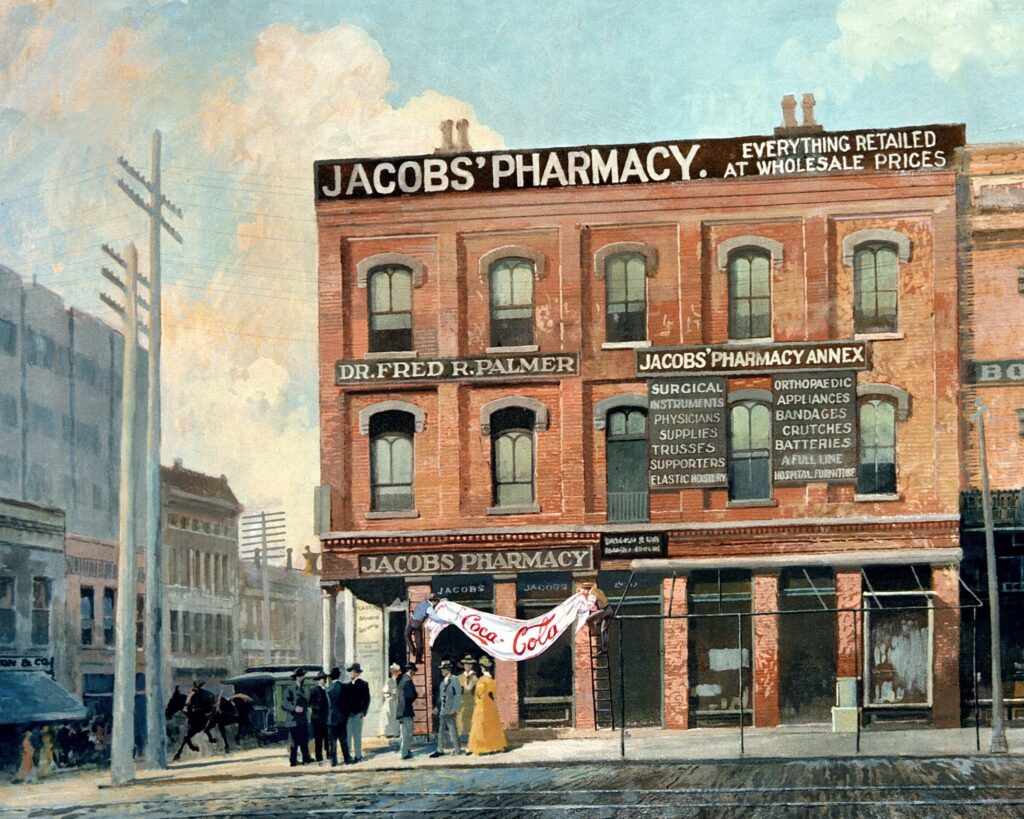
Food historian Waverley Root notes that the earliest known vanilla recipe is in the 1805 edition of Hannah Glasse’s “The Art of Cookery,” which recommends adding “vanelas” to chocolate. The first American vanilla ice cream recipe appears in Mary Randolph’s “The Virginia Housewife” (1824). By the late 1800s, vanilla’s popularity soared. It became the go-to flavor for ice cream and a key ingredient in soft drinks, including John S. Pemberton’s Coca-Cola. Launched in 1886, Coca-Cola was marketed as an “esteemed Brain tonic and Intellectual Beverage.”
Cultivation Challenges
One of the big issues with vanilla is how it’s actually make. Because of that process, next to saffron, it is one of the most expensive spices in the world.

Vanilla belongs to the orchid family and is a hemiepiphyte, meaning it relies on other plants for physical support. Vanilla plants can reach lengths of 15 to 20 meters and have a diameter of 1 to 2 cm, using tendril-like roots to climb tree trunks. These roots are thick, green, and range from 12 to 25 cm long and 5 to 8 cm wide. The aromatic flowers of the vanilla plant are delicate and fragile, forming light yellow trumpets that gather on floral buds. Their petals and sepals bloom for only one morning each season. If the flower is not pollinated in that 24 hour window, it wilts, dies, and drops to the ground.
“Frankly, given its sexual proclivities and narrow window of opportunity, the very existence of vanilla seems like an evolutionary long shot,” writes Rebecca Rupp, in “The History of Vanilla.”
Initially, attempts to cultivate vanilla outside its native region were unsuccessful. The vanilla orchid (Vanilla planifolia) requires a specific pollinator, the Melipona bee, which was native only to Mesoamerica, and sometimes by hummingbirds. (However, a 2006 study by Pesach Lubinsky, Matthew Van Dam, and Alex Van Dam suggest that the Euglossine bees may actually be the orchid’s primary pollinator.
According to Norohy, “On one flower bud, there can be up to 15 flowers at different stages of maturity. The grower needs to be there at the right time to pollinate the plant and produce a fruit. However, they cannot pollinate all the flowers, otherwise they risk exhausting the plant and producing beans that are too small.”
In 1841 a significant breakthrough occurred. Edmond Albius, a 12-year-old enslaved boy on the island of Réunion, discovered a method of hand-pollinating vanilla orchids. This technique uses a stick and the flick of the thumb. It revolutionized vanilla cultivation and allowed it to be grown in other tropical regions, such as Madagascar, the Comoros, India, Indonesia, and Tahiti.
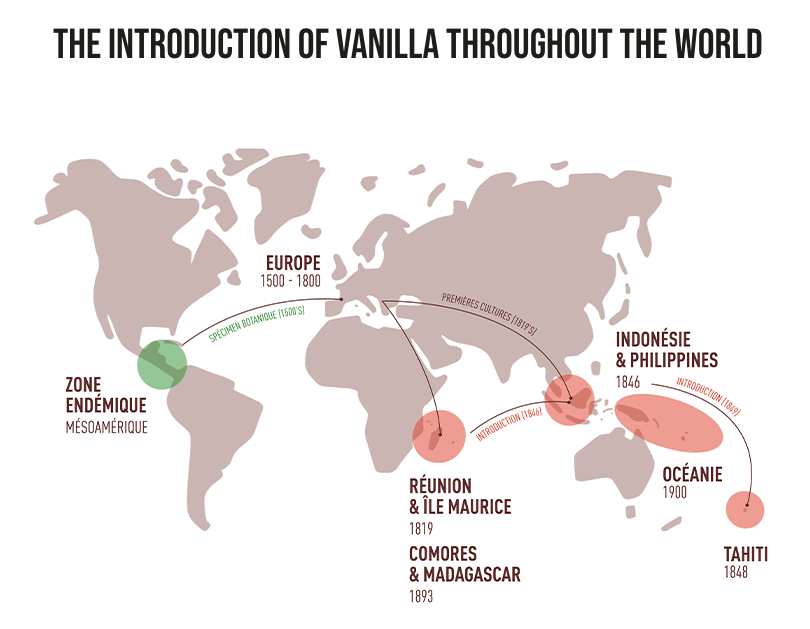
The world’s total vanilla production in June 2024 was 7,614 tonnes. Madagascar is the world’s largest producer of vanilla, accounting for over 80% of global production as of 2022. Other top producers include Indonesia, China, Mexico, and Papua New Guinea. Nearly all of the vanilla produced commercially today is hand-pollinated.
Vanilla Bean Production
Pollinating and growing the vanilla pods is not the only complicated process. Vanilla cultivation is labor-intensive. After pollination, the vanilla pods, which look like long string beans (10 to 27 cm long and 8 to 15 mm in diameter), take about nine months to mature, however, they reach their maximum size after 2 months.
Once they are hand-harvested, the beans undergo a curing process, which includes blanching, sweating, drying, and conditioning. This meticulous process can take several months and is crucial for developing vanilla’s characteristic flavor and aroma .
Vanilla Extract Development
The invention of vanilla extract is attributed to American pharmacist Joseph Burnett, who developed the first commercially produced vanilla extract in the mid-19th century.
Several methods exist in the market for curing vanilla; nevertheless, all of them consist of four basic steps: killing, sweating, slow-drying, and conditioning of the beans.
Killing
The vegetative tissue of the vanilla pod is killed to stop the vegetative growth of the pods and disrupt the cells and tissue of the fruits, which initiates enzymatic reactions responsible for the aroma. The method of killing varies, but may be accomplished by heating in hot water, freezing, or scratching, or killing by heating in an oven or exposing the beans to direct sunlight. The different methods give different profiles of enzymatic activity.
Hot-water killing may consist of dipping the pods in hot water (63–65 °C (145–149 °F)) for three minutes, or at 80 °C (176 °F) for 10 seconds. In scratch killing, fruits are scratched along their length. Frozen or quick-frozen fruits must be thawed again for the subsequent sweating stage. Tied in bundles and rolled in blankets, fruits may be placed in an oven at 60 °C (140 °F) for 36 to 48 hours. Exposing the fruits to sunlight until they turn brown, a method originating in Mexico, was practiced by the Aztecs.
Sweating
Sweating is a hydrolytic and oxidative process. Traditionally, it consists of keeping fruits, for 7 to 10 days, densely stacked and insulated in wool or other cloth. This retains a temperature of 45–65 °C (113–149 °F) and high humidity. Daily exposure to the sun may also be used, or dipping the fruits in hot water. The fruits are brown and have attained much of the characteristic vanilla flavor and aroma by the end of this process, but still retain a 60–70% moisture content by weight.
Drying
Reduction of the beans to 25–30% moisture by weight, to prevent rotting and to lock the aroma in the pods, is always achieved by some exposure of the beans to air, and usually (and traditionally) intermittent shade and sunlight. Fruits may be laid out in the sun during the mornings and returned to their boxes in the afternoons, or spread on a wooden rack in a room for three to four weeks, sometimes with periods of sun exposure. Drying is the most problematic of the curing stages; unevenness in the drying process can lead to the loss of vanillin content of some fruits by the time the others are cured.
Conditioning
Conditioning is performed by storing the pods for five to six months in closed boxes, where the fragrance develops. The processed fruits are sorted, graded, bundled, and wrapped in paraffin paper and preserved for the development of desired bean qualities, especially flavor and aroma. The cured vanilla fruits contain an average of 2.5% vanillin.
The familiar vanilla aromas and flavors only emerge after the beans are cured and dried. Once harvested, vanilla beans are sorted and graded. They are then blanched in hot water to stop fermentation and placed in large containers to sweat for 36 to 48 hours.
After curing, vanilla beans are sorted and graded based on length, appearance, and moisture content. Each producing country has its own grading system, with vendors sometimes using additional criteria. Top-grade beans are whole, dark, plump, oily, and free of blemishes, making them ideal for gourmet dishes. Lower-grade beans, which may have physical defects or lower moisture content, are often used for vanilla extract and fragrances. Despite higher prices, the best-looking beans don’t always have the highest concentration of flavor molecules.
| GRADE | COLOR | APPEARANCE/FEEL | APPROXIMATE MOISTURE CONTENT |
| Black | Dark Brown to Black | Supple with oily luster | >30% |
| TK (Brown, or Semi-Black) | Dark brown to black sometimes with a few red streaks | Similar to black but drier/stiffer | 25-30% |
| Red Fox (European Quality) | Brown with reddish variegation | A few blemishes | 25% |
| Red American quality | Brown with reddish variegation | Similar to European red but more blemishes and drier/stiffer | 22-25% |
| Cuts | Short, cut, and often split fruits, typically with substandard aroma and color |
Vanilla is an incredibly intricate and nuanced spice, containing between 250 and 500 distinct flavor and fragrance components. Essentially, vanilla is the plant, while vanillin is just one of up to 250 chemical compounds that contribute to the flavor we recognize as vanilla.
It takes approximately 5-7 pounds of green vanilla beans to produce just one pound of processed vanilla.
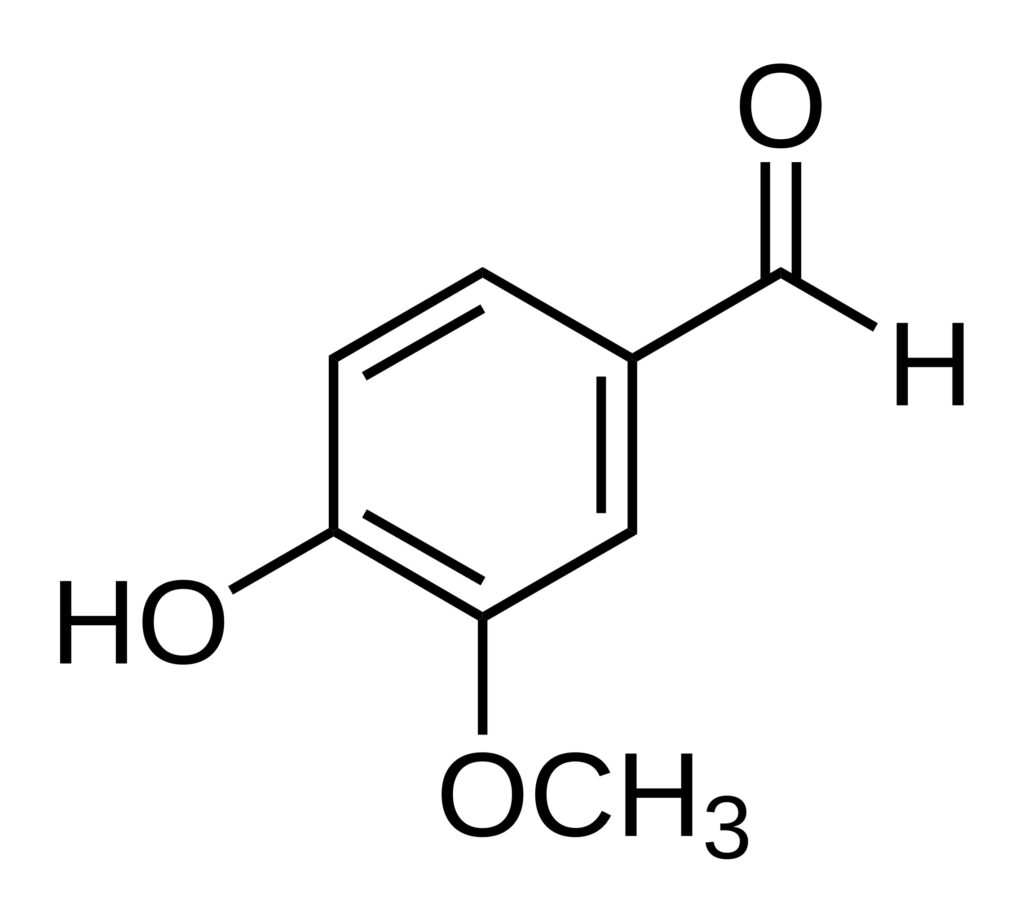
Vanilla extract is made by macerating and percolating vanilla beans in a solution of ethanol and water. This process captures the flavor compounds, primarily vanillin, and makes them easily accessible for culinary use.
Commercial Vanilla
Commercial vanilla extract is a popular flavoring derived from vanilla beans. The FDA in the United States requires that pure vanilla extract contains at least 35% alcohol and 13.35 ounces of vanilla beans per gallon during extraction.
There are different types of vanilla beans used to make vanilla extract, including Bourbon (Madagascar), Mexican, Tahitian, and Indonesian beans. Each type has a unique flavor profile. Tahitian vanilla, for example, is more floral and fruity, while Bourbon vanilla has a rich, creamy, and sweet flavor.
Nielsen-Massey, who is a sponsor of Club Coupe du Monde Team USA, has built a strong reputation in the culinary world for their high quality vanilla extracts and flavorings. The company uses a proprietary cold extraction process that preserves the more than 300 flavor compounds found in vanilla beans, resulting in a rich and complex flavor profile.
The company is committed to sustainable and ethical sourcing practices. They work closely with vanilla farmers to ensure fair trade and high-quality beans.
Vanilla Extracts:
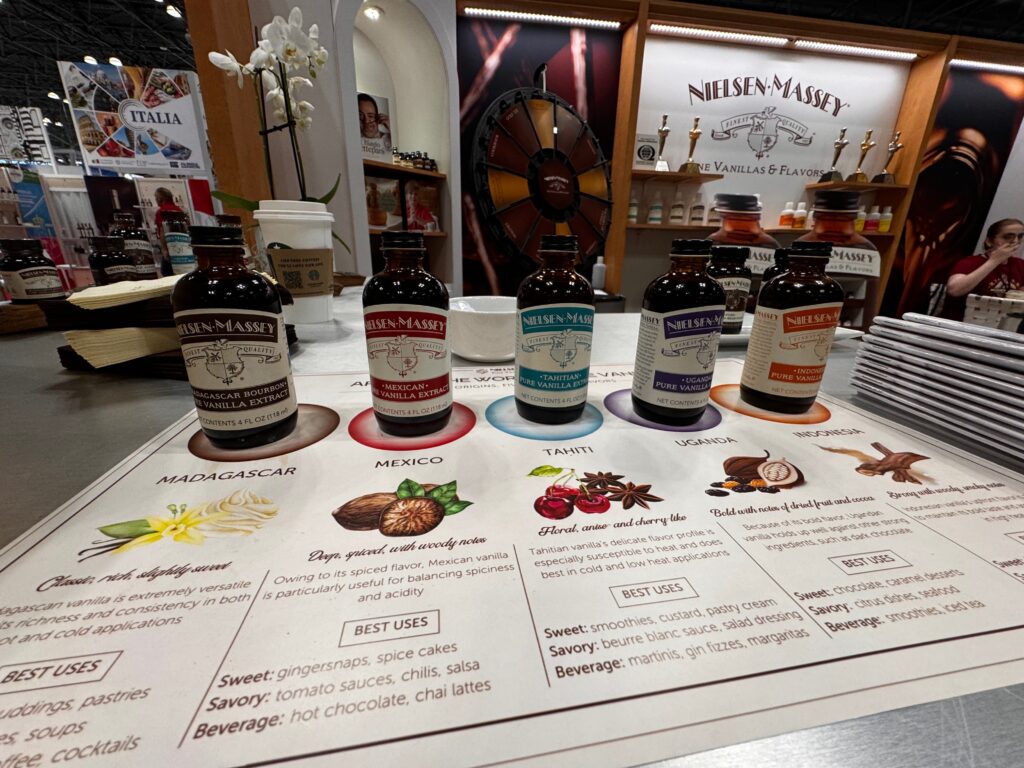
- Pure Vanilla Extracts: Nielsen-Massey offers a wide range of pure vanilla extracts, including Madagascar Bourbon, Mexican, and Tahitian varieties. Each type has its own distinct flavor profile.
- Vanilla Bean Paste: Combines pure vanilla extract with vanilla bean seeds, providing a rich flavor and visual appeal of the seeds.
- Vanilla Beans: Whole beans from different regions, each with unique characteristics.
- Organic and Fair Trade: The company also offers organic and fair trade vanilla products, ensuring high standards in environmental sustainability and ethical sourcing.
Other Flavor Extracts:
- Pure Flavor Extracts: Nielsen-Massey produces a variety of other pure flavor extracts, including almond, lemon, orange, chocolate, coffee, and peppermint.
- Paste and Powders: They also offer vanilla powder and other flavor pastes for various culinary applications.
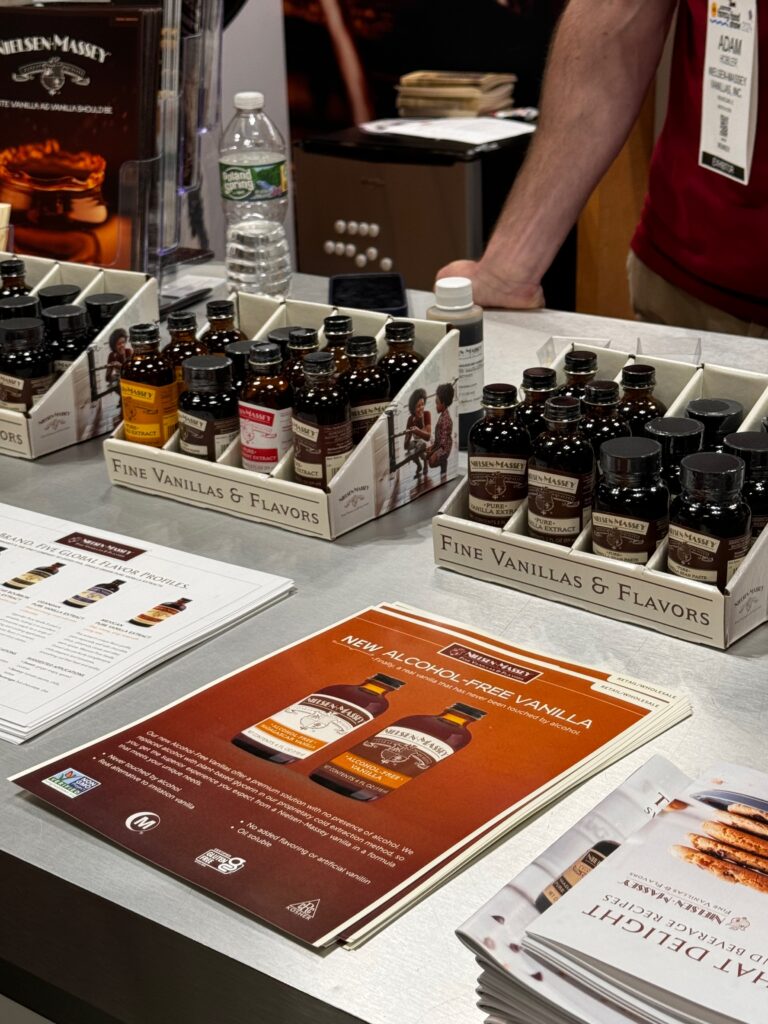
They have recently introduced two alcohol-free vanillas – alcohol-free vanilla and alcohol-free Madagascar vanilla. They offer their most loved vanilla without any alcohol, catering to dietary preferences and certain culinary techniques. They replaced alcohol with plant-based glycerin in their proprietary cold extraction method.
The quality of vanilla extract can vary significantly. Pure vanilla extract generally provides a more robust and nuanced flavor compared to imitation versions. To maintain its flavor, vanilla extract should be stored in a cool, dark place in a tightly sealed container. It can last for many years if stored properly.
Recent Shortages and Escalating Costs
In recent years, the vanilla market has faced significant challenges. Cyclones, crop theft, and climate change have severely impacted vanilla production, particularly in Madagascar, the largest producer. These factors have led to a shortage of vanilla beans and a dramatic increase in prices. At one point, vanilla became more expensive than silver by weight. This shortage has put financial strain on farmers and driven up costs for manufacturers and consumers worldwide .
Economic and Cultural Impact
Today, vanilla is a valuable global commodity. Madagascar continues to dominate production, accounting for approximately 80% of the world’s supply. The labor-intensive nature of vanilla cultivation, coupled with the risks posed by climate change and market volatility, has led to fluctuating prices and economic challenges for farmers .
The top importers of vanilla in 2022 were the United States, France, Germany, Canada, and the Netherlands. The United States, France, and Germany account for about 80% of global vanilla trade volume.
Vanilla’s journey from the Totonac people of Mexico to a cherished global spice is a testament to its enduring appeal. Despite the challenges of cultivation and market dynamics, vanilla remains a beloved ingredient, enriching culinary creations and captivating our senses with its timeless aroma and flavor.
References
- Koehler, J. (2012). Vanilla: The Cultural History of the World’s Favorite Flavor and Fragrance. Penguin.
- Dweck, A. C. (2000). “Ethnobotanical Uses of Plants for Cosmetics.” International Journal of Cosmetic Science, 22(1), 43-62.
- Freeman, M. (2014). “Vanilla: A Global History.” Reaktion Books.
- Mortensen, B. (2005). “The Vanilla Industry: A Global Economic Perspective.” Economic Botany, 59(1), 52-62.
- “The Story of Vanilla.” Vanilla Queen. Retrieved from https://vanillaqueen.com/story-of-vanilla.
- Lucas, A. (2018). “Why Vanilla Is So Expensive.” The New York Times. Retrieved from https://www.nytimes.com/2018/06/19/style/vanilla-prices.html.
- Peterson, L. (2019). “Vanilla Prices Surge as Shortages Continue.” Bloomberg. Retrieved from https://www.bloomberg.com/news/articles/2019-03-26/vanilla-prices-surge-as-global-shortages-continue.
- “Vanilla Market Report 2020.” FAO. Retrieved from http://www.fao.org/3/ca8836en/CA8836EN.pdf
- “The History of Vanilla.” National Geographic. 23 October 2014. https://www.nationalgeographic.com/culture/article/plain-vanilla
- “The Bittersweet Story of Vanilla.” Smithsonian Magazine. 3 April 2017. https://www.smithsonianmag.com/science-nature/bittersweet-story-vanilla-180962757/
- Nielsen-Massey Vanilla & Flavors website.
- Norohy vanilla website
- Wikipedia